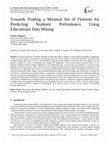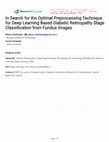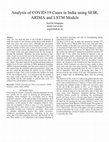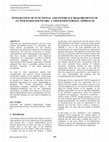Papers by Souvik Sengupta

International Journal of Modern Education and Computer Science, Jun 8, 2023
An early prediction of students' academic performance helps to identify at-risk students and enab... more An early prediction of students' academic performance helps to identify at-risk students and enables management to take corrective actions to prevent them from going astray. Most of the research works in this field have used supervised machine learning approaches to their crafted datasets having numerous attributes or features. Since these datasets are not publicly available, it is hard to understand and compare the significance of the chosen features and the efficacy of the different machine learning models employed in the classification task. In this work, we analyzed 27 research papers published in the last ten tears (2011-2021) that used machine learning models for predicting students' performance. We identify the most frequently used features in the private datasets, their interrelationships, and abstraction levels. We also explored three popular public datasets and performed statistical analysis like the Chi-square test and Person's correlation on its features. A minimal set of essential features is prepared by fusing the frequent features and the statistically significant features. We propose an algorithm for selecting a minimal set of features from any dataset with a given set of features. We compared the performance of different machine learning models on the three public datasets in two experimental setupsone with the complete feature set and the other with a minimal set of features. Compared to using the complete feature set, it is observed that most supervised models perform nearly identically and, in some cases, even better with the reduced feature set. The proposed method is capable of identifying the most essential feature set from any new dataset for predicting students' performance.
The advent of asynchronous web based learning systems has helped the learner in a self paced, per... more The advent of asynchronous web based learning systems has helped the learner in a self paced, personalized and flexible learning style. It can be even more useful with a supportive synchronous tutorial (question-answer) session. The challenge is to provide sufficient information to the instructor about the learner's experience in that particular course. In this paper we have designed an automated scaffolding technique to hold these vital information's about the learner which can be accessed and used by the instructor in the synchronous tutorial session to make the system more adaptive.

Background: Diabetic retinopathy (DR) is a complication of diabetes mellitus, which if left untre... more Background: Diabetic retinopathy (DR) is a complication of diabetes mellitus, which if left untreated may lead to complete vision loss. Early diagnosis and treatment is the key to prevent further complications of DR. Computer-aided diagnosis is a very effective method to support ophthalmologists, as manual inspection of pathological changes in retina images are time consuming and expensive. In recent times, Machine Learning and Deep Learning techniques have subsided conventional rule based approaches for detection, segmentation and classification of DR stages and lesions in fundus images. Method: In this paper, we present a comparative study of the different state-of-the-art preprocessing methods that have been used in deep learning based DR classification tasks in recent times and also propose a new unsupervised learning based retinal region extraction technique and new combinations of preprocessing pipelines designed on top of it. Efficacy of different existing and new combination...

Journal of Computational Social Science, 2021
This paper presents a study on legislative text analysis to automate the process of identifying a... more This paper presents a study on legislative text analysis to automate the process of identifying appropriate sections of laws that are applicable to the cases. We propose a methodology that includes supervised machine learning (ML) and natural language processing (NLP), and demonstrated our idea on the archived case studies of Indian Income Tax Act of 1963 (Income tax act, 1961 complete act-bare act, 2008), with applicable law sections and subsections, available at 'LegalCrystal' (https:// www. legal cryst al. com/) data repository. We consider the problem as a multilabel classification task, where multiple law sections could be applied on one case. The one-versus-rest wrapper is applied over the conventional ML models like logistic regression, Naïve bayes, decision tree and support vector machine to perform the multi-label classification. The proposed methodology includes necessary preprocessing and word embedding of texts, pipelining of transformers and ML models and evaluation of the trained models. We analyzed the performance of these different ML models by fine-tuning the hyper-parameters and observed a highest F1 score of 0.75 for support vector machine. Although this work is limited to cases involving income tax laws, the proposed methodology is adaptive to any other law sections.

After one year from the start of the COVID-19 pandemic in India, the country is now having a stea... more After one year from the start of the COVID-19 pandemic in India, the country is now having a steady decay in the number of daily new cases and active cases. Although the vaccination process is about to start from mid of January 2021, it would not affect the number of daily cases at least for the next three to four months for obvious reasons like phase-wise implementation and six to eight weeks time span required from the first dosage to develop the immunity. Therefore, the prime question is now, where would we reach at the end of the first quarter of 2021, and what could be the number of new cases and active cases before the vaccination immunity starts working. This paper analyzes the growth and decay pattern of Indian COVID-19 cases with help of SEIR epidemical modeling, ARIMA statistical modeling, and time series analysis by LSTM. The models learn the parameter and hyper-parameter values that are best suited for describing the pattern for the COVID-19 pandemic in India. Then it tr...
This work tries to explain the relevancy of distributed active database in some real life complex... more This work tries to explain the relevancy of distributed active database in some real life complex networked transport system and medical science systems which also involve ambient intelligence, pervasive computing and perceptive environments. These environments are places with the ability of perceiving the context through sensors and other mechanisms. The core of the system relies on a set of modular agents equipped with rules. Those rules are composed of triggers, conditions and actions that enable them to express desired behaviors of the environment. One generic model of distributed active database is done by color time Petri Net which is appropriate in several real life applications and helpful to make understand the complex concurrent activities involved in these applications.

Since the start of COVID-19 pandemic, the main question that every country is desperately looking... more Since the start of COVID-19 pandemic, the main question that every country is desperately looking for an answer is when the number of daily new infection cases would decline. At the end of July 2020 (time of writing this paper), many countries have already managed to decrease the number of daily infections as well as total infections and death cases. India imposed four consecutive lockdowns which spanned over 61 days and currently it is being withdrawn phase by phase. However, the number of new cases and number of fatality is still on the rise. This paper investigates what could be the possible time required for India before the numbers of daily infected people could start declining and what could the peak value hit by then. Three different models are used independently for initial predictions using statistical ARIMA model, SAR epidemical model, and ML regression model. These three results are fit into a stacked LSTM model which makes the final prediction. It is forecasted that the ...
Proceedings of International Conference on Advanced Computing Applications, 2021

International Journal of Web-Based Learning and Teaching Technologies, 2022
The undergraduate and postgraduate studies of colleges and universities in India have been affect... more The undergraduate and postgraduate studies of colleges and universities in India have been affected badly amidst the lockdowns for COVID-19 pandemic. The Government has insisted to start the academic activity through online platforms. The biggest concern for the academic institutions now is to select an appropriate e-learning platform. This paper compares different features and facilities available in some widely used online platforms and analyze their suitability from the perspective of socio-economic constraints of students in India. A generic framework for conducting online classes is described that meets the special requirements of the unprivileged students. Some strategic plans to overcome the challenges are identified and suggested. A technical solution for implementation of time-bound assessment module is also proposed.
International Journal of Learning and Teaching, 2018
Education and Information Technologies, 2016
El objetivo de este documento es contribuir a la discusión acerca de los efectos del salario míni... more El objetivo de este documento es contribuir a la discusión acerca de los efectos del salario mínimo en el mercado de trabajo. Argentina brinda la oportunidad de explorar esta temática en profundidad dado que en los últimos años-desde 2003-el salario mínimo se modificó en numerosas ocasiones. Se analizaron los niveles de salario mínimo durante el período y su impacto en la distribución de salarios y en el empleo. Mediante el uso de datos de panel se estimaron también las chances de los individuos de permanecer en el mismo status laboral luego de que se produjeran variaciones en esta regulación laboral. La evidencia aportada reveló que las modificaciones en el salario mínimo no contrajeron la demanda de empleo ni incentivaron la precariedad laboral.
In an e-Learning system a learner may come across multiple unknown terms, which are generally hyp... more In an e-Learning system a learner may come across multiple unknown terms, which are generally hyperlinked, while reading a text definition or theory on any topic. It becomes even harder when one tries to understand those unknown terms through further such links and they again find some new terms that have new links. As a consequence they get confused where to initiate from and what are the prerequisites. So it is very obvious for the learner to make a choice of what should be learnt before what. In this paper we have taken the data mining based frequent pattern graph model to define the association and sequencing between the words and then adopted the Ant Colony Optimization, an artificial intelligence approach, to derive a searching technique to obtain an efficient and optimized learning path to reach to a unknown term.

Education and Information Technologies, 2015
This paper illustrates an approach for architectural design of a Learning Management System (LMS)... more This paper illustrates an approach for architectural design of a Learning Management System (LMS), which is verifiable against the Learning Technology System Architecture (LTSA) conformance rules. We introduce a new method for software architectural design that extends the Unified Modeling Language (UML) component diagram with the formal architectural style of Acme, hence, combines the advantages of the visual appeal of a graphical method and preciseness of a formal method. We propose some new stereotypes for UML component-connector style to incorporate Acme style within UML. A UML meta-model for the design components is also proposed to elucidate the relationships between the components. We also propose a verification method to ensure that the design artifact is holding conformance with LTSA standard. The design process as well as the verification process entails additional knowledge about the domain, which is supplied by the domain Ontology. The LTSA conformance rules, written in natural language, are represented more formally with help of Conceptual Graph representation, before using them in the verification process. Finally, we introduce a verification method that tries to find out a design pattern in the architectural design that conforms to the particular conformance rule intended to check. The verification process also introduces a goodness measure of the conformance. Keywords Architectural design. UML. Acme. LMS. LTSA. Design verification 1 Introduction LMS is a software application that supports different teaching-learning activities like administration, documentation, authoring, tracking, reporting and delivery of the courses. The usage of LMS in recent times has a broader spectrum, from colleges and
Procedia Computer Science, 2015
The objective of this paper is to demonstrate the use of formal methods in a uniform way for func... more The objective of this paper is to demonstrate the use of formal methods in a uniform way for functional as well as interfacerequirements. We propose some add-ons to 'Vienna Development Method Specification Language'syntaxes to cover the interface-requirements of a web-based application. We also propose a framework to support the transformation of the conventional SRS to a design specification, and a Finite State Machine based verification model, to test the design specification against the SRS.
International Conference on E-Business, Enterprise Information Systems, E-Government, and Outsourcing, 2010

Artificial Intelligence and Applications / 794: Modelling, Identification and Control / 795: Parallel and Distributed Computing and Networks / 796: Software Engineering / 792: Web-based Education, 2013
Analysing user requirements properly is the key to any software development process. In contempor... more Analysing user requirements properly is the key to any software development process. In contemporary web based software developments the user interface requirements are predominant among the non functional requirements. The end-users' involvement in interface requirements has made it challenging for the designers to map these interface requirements with functional requirements. As a consequence we often use different specification languages for different types of requirements but then interface requirements, if handled separately May lead to traceability problem for the developers, especially in web based application development. In order to make requirements analysis both comprehensible and rigorous, formal requirements specification methods are very important. In this paper we have tried to describe how interface requirements can be specified in a formal way in connection with the functional requirements for a better understanding in designing. The Vienna Development Method Specification Language (VDM-SL) being a well established formalizing tool for user requirements specification, we propose some add-ons to this tool to help in formalizing these types of requirements. We have also used this technique in a case study to strengthen our proposal.

Advances in Intelligent Systems and Computing, 2014
The use of graphical methods such as unified modelling language (UML) in conjunction with formal ... more The use of graphical methods such as unified modelling language (UML) in conjunction with formal methods such as Vienna development method (VDM) can be significantly beneficiary in the software design phase due to their complimentary features. UML diagrams are very useful in communication among different stakeholders, but at the same time, being semiformal in nature, they lack formal syntax and preciseness due to textual description in notations. This makes it challenging to verify the design against the requirements. Conversely, a formal specification language like VDM-SL has the advantage of preciseness an unambiguous modelling, but unable to provide ease of understanding like UML. This paper presents a methodology that integrates the use of UML and VDM-SL in software design phase and also proposes a verification technique for the design artefacts with the requirements. A case study of intelligent learning management system (ILMS) is used in this paper to illustrate the proposed work.

ACM SIGSOFT Software Engineering Notes, 2015
A systematic approach in requirement engineering helps in discovering and understanding the requi... more A systematic approach in requirement engineering helps in discovering and understanding the requirements at different levels of abstraction as well as makes the requirements traceable and verifiable early in the project. This paper presents a methodology for requirement engineering by using a combination of formal and semiformal techniques to model software requirements for analysis and verification. The proposed framework incorporates requirement-analysis and requirement-verification models, which are guided by the Domain Model represented by a Conceptual Class diagram and the defined Ontology. The proposed approach is particularly useful when requirements are defined in hierarchical levels of abstraction and traceability between a requirement at a detailed level and its correspondence at an abstract level is required. The proposed framework also allows verification of the accordance of the requirements with respect to the Domain Model. The requirement analysis model at each level ...
Arxiv preprint arXiv:1201.3981, 2012
Abstract: The success of e-Learning is largely dependent on the impact of its multimedia aided le... more Abstract: The success of e-Learning is largely dependent on the impact of its multimedia aided learning content on the learner over the hyper media. The e-Learning portals with different proportion of multimedia elements have different impact on the learner, as there ...











Uploads
Papers by Souvik Sengupta